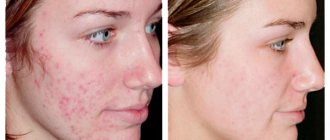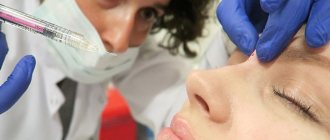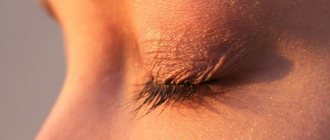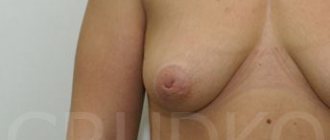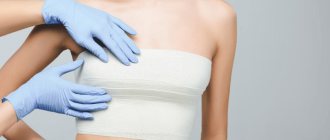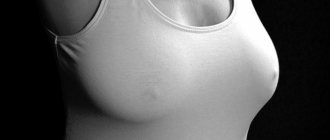Inverted nipples refer to a condition in which part or all of the nipple is retracted into the gland.
Nipple inversion can be distressing for the patient, but can also cause functional problems by being a source of inflammation and irritation. It may also make it impossible to breastfeed. The frequency of occurrence in women is 2–3% and in 50% of cases it is inherited. This condition can be congenital or acquired, caused by breast infections, tumors, breast surgery, or gigantomastia.
Histologically, there is a lack of dense connective tissue under the base of the nipple, which usually plays an important role in maintaining its projection. Instead, there are fibrous strands that cause the milk ducts to shorten and become retracted.
Causes
The most common causes of inverted nipples are:
- congenital pathology
: may be a consequence of underdevelopment of the glandular ducts or contraction of the smooth muscles of the SAH; - postoperative deformities
: caused by contraction of the milk ducts against the background of scar formation on the pedicle of the SAH.
Such nipples are also found in cases of mammary gland hypertrophy caused by hormonal imbalances, age-related changes or genetic predisposition.
Using nursing pads
An inverted papilla (natural causes in women are not a reason to refuse breastfeeding) during lactation can be corrected by using specialized overlays. They can be made of latex or silicone (the latter is preferred due to ease of use and durability).
The soft material fits snugly to the mother's breast and completely follows the natural shape of the nipple. Holes in the device (near the nipple and along the edges) allow milk to be released in doses during sucking, and also allow the baby to smell the mother’s smell.
Recommended pads:
| Company name | Device characteristics | Average price (in rubles) |
| AVENT | The pad is made of silicone. The device enhances lactation and reduces discomfort and pain during feeding. | 1100 |
| NUC | Triangular shaped silicone pads. Available in 2 sizes. When used, it stimulates milk production. | 400 |
| Philips Avent | Made from ultra-thin silicone. It has no foreign odors and does not distort the taste of milk. When feeding, stimulates lactation. | 650 |
| Contact | The pads are made of silicone. Convenient for gripping when feeding (for a newborn). They relieve pain in the presence of cracks and prevent injury to the nipple during teething in a child. | 600 |
When choosing a device, it is recommended to obtain a preliminary consultation with a pediatrician.
Classification
Congenital nipple retraction can have three degrees of severity:
- initial - the nipple is easily pulled outward when the areola is palpated;
- medium - the nipple can also be pulled out during palpation, but has a clear tendency to retract; moderate tissue fibrosis is observed;
- severe - inversion and retraction of the nipple are significant, it is impossible to manually return the nipple to the physiological position; severe fibrosis develops.
At the last stage, with which patients mostly come to our clinic, only surgical intervention will help correct the situation.
Consequences and complications
Inverted nipples are not only an aesthetic discomfort.
Pathology may be accompanied by the development of the following complications:
- girls and impressionable women may develop an inferiority complex with subsequent disruption of psychological balance;
- deterioration of sexual desire. The nipple contains erogenous zones that are responsible for sexual arousal, and there is also psychological discomfort. Lack of intimacy can provoke the development of pathologies in the genitals and lead to hormonal imbalance;
- Difficulties with natural feeding and when expressing excess milk. The latter can lead to the development of mastitis;
- accumulation of sweat and dust in small folds formed by the inverted nipple. This can lead to the development of inflammatory processes in the mammary glands;
- soreness of the nipple when it comes out (typical for grades 1 and 2).
Even if the nipple is retracted due to physiological characteristics, it is recommended to undergo examination by a mammologist and, if possible, return the nipples to their natural shape.
Preparation
Preparation for surgical correction of inverted nipples, as well as for any other operation on the mammary glands, requires a complete examination. Mandatory tests include blood and urine tests. The blood is examined for coagulability (a coagulogram is done), Rh factor and group, as well as sexually transmitted diseases and other infections transmitted through unprotected sexual intercourse (HIV, hepatitis, syphilis, etc.), general and biochemical tests are done.
Instrumental diagnostic methods include:
- Ultrasound of the mammary glands;
- Doppler ultrasound of the lower extremities;
- electrocardiogram;
- radiography (fluorography).
To be admitted to surgery, you need a consultation with a therapist, which you can get in any clinic, and a report from our anesthesiologist. Based on the test results, the issue of choosing the safest type of pain relief is decided. If necessary, consultations with other specialists may be necessary.
Simulation of the results of plastic surgery is carried out using a full-size Crisalix mirror, looking into which you can see your future breasts in real time.
Non-surgical methods. Carrying out corrective procedures
An inverted papilla in women at grades 1 and 2 can be restored using non-surgical methods (for natural causes of the pathology).
Hoffman massage
To carry out the procedure, you need to place your thumbs opposite each other near the nipple. Make opposite movements with them (one finger moves from the nipple, the other to the nipple). Perform manipulations in a circle around the nipple. Initially, perform the procedure 2 times a day with a gradual increase up to 5 times. The duration of therapy is from 6 months to 5 years.
Erotic massage
During intimacy, perform oral caresses of the mammary glands. Additionally, roll the nipples between your thumb and forefinger. To prevent the nipple from quickly retracting, you need to moisten it with cool water. Do the procedures carefully without sudden or painful movements.
Using a breast pump
The device can be used both during breastfeeding and without lactation. To carry out the procedure, it is important to select a flange (silicone pad) of the required diameter (it must completely cover the nipple).
When pulling out the nipple with a breast pump, you need to firmly attach the pad to the breast and select the appropriate operating speed (there should be no painful sensations). Once the nipple is straightened, the procedure is completed.
Using an inverted syringe
To straighten the nipple you will need a 10 cc syringe. To use, you need to cut off the base where the needle should be attached. The piston with handle is inserted from the cut side.
Next, the syringe (with the uncut side) is applied near the nipple and by pulling the piston, the papilla is straightened. Before removing the syringe, you should push the plunger back slightly to relieve pressure and avoid pain.
Application of the Niplette vacuum corrector
The corrector allows you to keep the nipple in its natural state for a long time. The Niplette consists of a small transparent cap that is secured to the nipple with a syringe. To secure the Niplette, you need to lubricate the areola, nipple and base of the cap with a special ointment (indicated in the instructions).
The cap is then connected to the syringe and applied to the nipple. A syringe is used to create a vacuum, which pulls out the nipple. Next, the syringe is disconnected. Start wearing the corrector for 15 minutes with a gradual increase in wearing up to 8 hours.
How to get rid of inverted nipples using nipple formers?
Nipple formers are specialized silicone covers with a hole in the center. The devices are tightly fixed to the chest and maintain the nipple in an excited state.
Accessories not only allow you to gradually return the mammary gland to its natural shape, but also facilitate the process of lactation. It is important to rinse the pads in a timely manner, otherwise contamination of the device will lead to skin irritation and pain.
How to fix it with piercing?
“Earrings” used for piercing do not allow the nipple to retract back. When choosing this method, it is important to choose a proven salon and suitable decoration. The advantage of piercing is the preservation of the possibility of breastfeeding; the procedure takes a short period of time and has a 100% result in straightening the nipple.
About the operation
To correct inverted nipples, the surgeon crosses the milk ducts located at the very base of the nipple using one of the techniques. Traditionally, nipple plastic surgery begins with making a small incision through which it is pulled up using a special single-prong hook and at the same time the ducts inside are crossed. At the end of all manipulations, a suture is applied in the shape of a P, which is located parallel to the incision line. Sutures are removed on the fifth day. The operation is performed under general anesthesia.
If the patient wishes, breast augmentation with silicone implants can be performed along with SAH correction. If there is severe ptosis, mastopexy is indicated, which is often supplemented by one-stage augmentation.
Nipple correction
The beauty of the breast consists not only of its volume and shape, because the full picture plays into aesthetic perception. Neat and symmetrical nipples are considered the standard of feminine breasts, but, unfortunately, not every woman is able to boast of this. Areolas that are too large after feeding or naturally elongated nipples can bring a lot of discomfort to a woman, making her feel embarrassed about her naked appearance. Therefore, here plastic surgeons come to the rescue, who can perform nipple correction or areola correction in one operation.
What other symptoms occur?
In half of the cases, a change in the shape of the areola-nipple zone is accompanied by pain; greater sensitivity to touch or discomfort is possible. The pain can be cyclical, which is in favor of the premenstrual reaction; constant long-term pain with a clear localization in one place indicates a neurological or tumoral nature.
Only a specialist who has been observing all variants of mammary gland pathology for many years, several times a day, can finally understand what is normal and what should be classified as pathology. Such a mammologist specialist is seen at the international clinic Medica24, and colleagues specializing in other areas of medicine always come to him for diagnostic assistance. Therefore, in our Clinic the percentage of diagnostic errors is reduced to zero. Sign up for a consultation by phone +7 (495) 230-00-01
Effect on breastfeeding
Inverted nipples usually do not become a serious problem when feeding a baby.
While inverted nipples can be challenging, babies can usually feed from them by grasping the areola and pressing it against the roof of their mouth. That is, in most cases, with sunken nipples, women retain the ability to breastfeed.
In addition, it should be noted that nipple stimulation often causes partial nipple release. To achieve this effect, nursing mothers can use a variety of techniques.
Some women find that their inverted nipples begin to emerge gradually during pregnancy and breastfeeding.
At what age do girls' breasts begin to grow?
A schoolgirl may have her first crush. There is no erotic connotation here, but there is a sexual connotation - the girl begins to identify herself as a future woman.
Before this change affected mainly the psychological sphere, but now the little woman is already trying to master the role that she will have to play throughout her life. In boys, there is no such clear boundary before puberty.
During adolescence, a girl begins to identify herself as a woman
Mothers of girls often wonder when will their daughter start to grow breasts? Is it too late? Isn't this happening too early? Is it necessary to consult a doctor?
The emergence of such questions is not uncommon due to changes in the timing and pace of puberty in girls, as well as the likelihood of specific problems arising.
Most girls enter puberty at age 11. A girl's first period begins only at the age of 13. But there are exceptions: a girl can reach biological maturity at 8-9 years old, or the process is delayed until the age of 13.
Girls reach biological maturity at 11-13 years old
Sometimes biological maturity occurs at 7 years of age or only at 15 years of age. Achieving puberty at an earlier or later age is not associated with dysfunction of the endocrine glands. They just have a different, individual “schedule” of work, which is inherited from their parents.
The girl begins to grow rapidly (up to 8-10 cm per year). Body weight also increases (from 5 to 9 kg), but the girl does not gain weight. A good appetite keeps pace with active growth.
A number of changes occur in the girl’s body
Other changes are associated with this period: the girl notices that her mammary glands have enlarged. At the first stage, you can visually detect a slight protrusion of the isola. After this, the mammary gland takes on the appropriate shape.
The process of formation of the mammary gland, or scientifically “thelarche,” lasts several years and is divided into stages. The size and shape of the breasts are determined by the genetic predisposition of the girl. But there are factors influencing the development of girl’s breasts:
- girl's health level
- nutritional pattern
- heredity (the shape and size of the breasts mainly depends on the mother’s genes, the genetics of the father’s or mother’s relatives)
- constitutional features (petite girls cannot have large breasts, large girls have larger breasts)
- body weight (while gaining kilograms, a girl may notice that her breasts are increasing in size, and weight loss diets can negatively affect the normal formation of the mammary glands, since breast volume is directly related to the amount of fat deposits in the body)
- An active lifestyle and regular exercise strengthen the fat ligaments, which tightens the adjacent muscles. The breasts are visually enlarged, which improves their shape. However, it is impossible to increase breast size by doing exercises, since there are no muscles in the mammary gland itself
- level of hormones in the blood (hormonal levels can change at different periods of life. This process is influenced by puberty and the menstrual cycle). After taking hormonal drugs, breasts may begin to increase in size, but this effect is temporary. Stopping taking hormonal drugs will cause the breasts to return to their previous size and shape.
You cannot increase your breast size through exercise alone.
Poor health, lack of appetite, or, conversely, excess weight will contribute to the size and shape of the breast. Glandular tissue is not characterized by development, therefore, with excess weight, the breasts sag and lose their elasticity.
What can't you do?
If there is an inverted nipple, a woman should initially undergo a full diagnosis and identify the cause of the deviation. If retraction is a symptom of the development of pathology, then various methods (massages, pads, vacuum devices) will provoke the development of complications from manipulation.
Also, after eliminating the cause, the shape of the nipple can return to its natural shape on its own. All methods of nipple traction are not recommended for use before the age of 18. Before this age, the glands are still developing, and procedures can disrupt the formation and development of the glands.
A retracted papilla is not only a psychological discomfort, but also causes difficulties during the lactation process. To confirm the pathology, you can initially perform a self-diagnosis to determine the degree of nipple retraction.
The final diagnosis, identifying the cause and method of treatment, is determined by the doctor. Manual methods, onlays or surgical treatment are used to eliminate pathology in women.
Author: Kotlyachkova Svetlana

